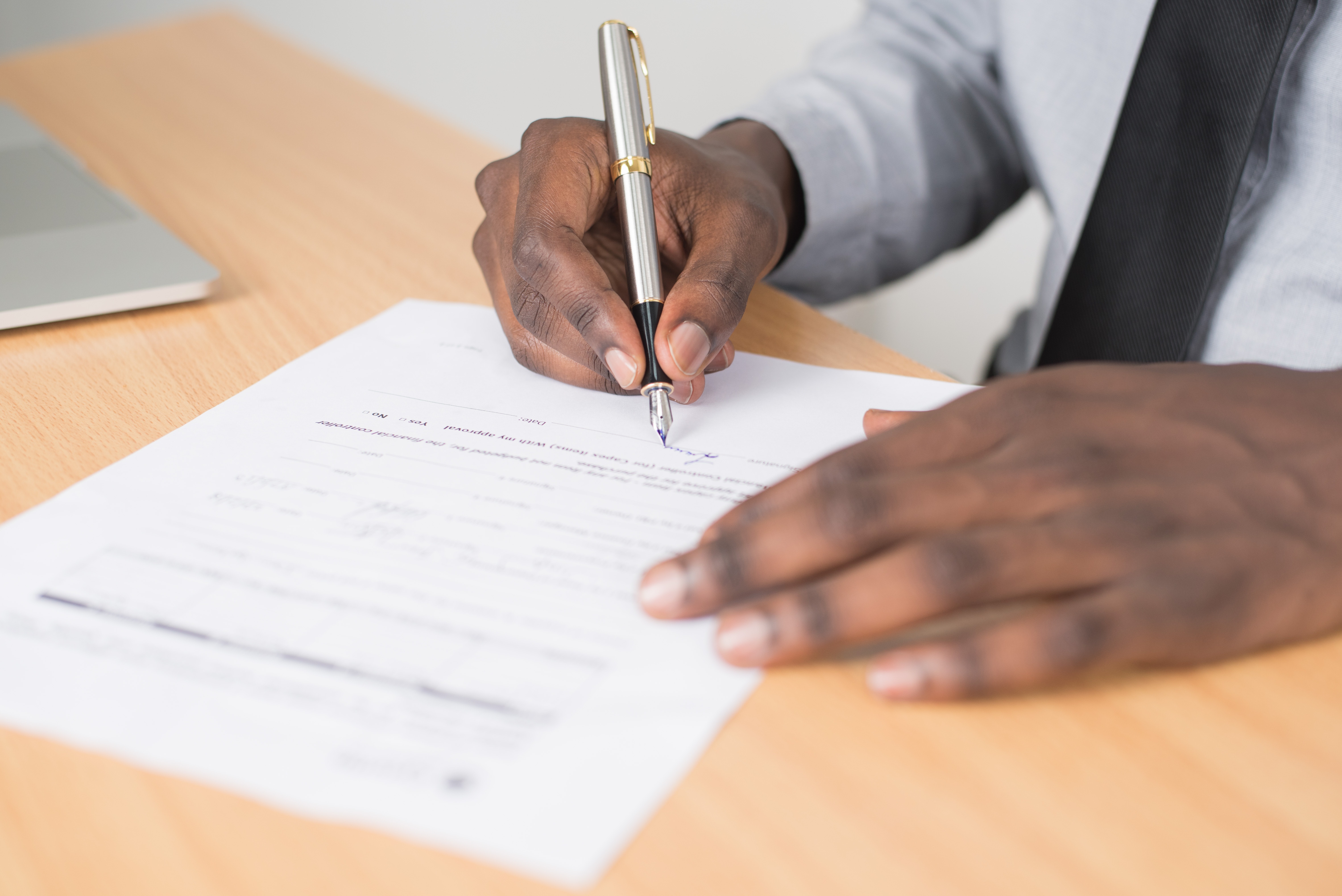The Social Security Administration (SSA) has the responsibility of determining which individuals should be awarded disability benefits. With such a wide number of illnesses and injuries that could potentially keep someone out of work, this is not a simple task.
The SSA created a medical guide called the “Blue Book” to help standardize the way in which disability benefits are doled out.
The Blue Book, also referred to as the Listing of Impairments, contains various physical and mental conditions that might qualify an individual for Social Security Disability Insurance (SSDI) benefits.
What Is Spinal Stenosis?
You may be wondering “What is spinal stenosis?” if you recently received a diagnosis of this condition. Although the best source of information on this topic is your doctor, the following overview may answer some of your basic questions.
Spinal stenosis is a condition you might develop when the space surrounding your spine is too small or narrow in certain areas. Excessive narrowness can place pressure on the spine and the nerves traveling through it.
Spinal stenosis can affect various areas of the spine. It’s most common in the neck and lower back.
It’s technically possible to have this condition without experiencing any symptoms. Symptoms you might experience if you have a case of spinal stenosis affecting the neck include:
- Numbness and/or neck pain.
- Weakness, loss of sensation, or a tingling feeling affecting a limb, hand, and/or foot.
- Balance issues.
- Difficulty walking.
- Bowel and/or bladder control problems.
When a case of spinal stenosis affects the lower back, common symptoms include:
- Pain and or cramping in one leg or both.
- Symptoms that may worsen when walking or standing for a long time.
- Back pain.
Spinal stenosis has many potential causes. Sometimes, an individual develops this condition simply because they were born with narrow space surrounding their spine.
However, it's more common for individuals with spinal stenosis to develop this condition as a result of other health issues that may cause a narrowing of the spinal canal. Examples of such health issues include tumors, bone spurs, herniated discs, and various types of spinal injuries.
Can You Get Disability For Spinal Stenosis?
Yes, you can get disability benefits for spinal stenosis. You can qualify for disability for spinal stenosis if you are unable to work for at least 12 months. You will also need to review the SSA's Blue Book (see below) to determine how your spinal stenosis can qualify for disability.
Is Spinal Stenosis a Permanent Disability?
Spinal stenosis is a disabling condition caused by the narrowing of the gaps between individual spinal vertebrae. Because the vertebrae are closer together, they tend to compress the nerves that lie inside the spine, especially the spinal cord.
Spinal stenosis is most commonly experienced in the neck and lower part of the back. Cervical stenosis is the name given to the condition in the neck and is a little less common than lumbar stenosis, experienced in the lower back. This is the most common form of spinal stenosis.
Typical symptoms of spinal stenosis which could limit a sufferer’s ability to continue working include:
- extreme pain, which may be worse on standing, bending or walking;
- numbness or an inability to sense touch or pressure in the affected area;
- tingling, caused by nerve compression;
- weakness;
- loss of bladder or bowel control.
Spinal stenosis is often progressive, although in its earlier stages may be treated by surgery. In more advanced stages, it may cause such severe pain on moving that it becomes impossible to continue working, even if you are used to doing a relatively sedentary job. If it gets to this stage, you may qualify for a social security disability benefit from the Social Security Administration (SSA).
Spinal stenosis is listed in the SSA’s Blue Book, so this makes it easier to determine whether the symptoms you are experiencing qualify you for a disability benefit. Spinal stenosis may be operable or improved on treatment, so a disability benefit may only be available for those sufferers who cannot continue working for at least the following 12 months or more after a claim.
Spinal stenosis in some cases can be a permanent disability if it effects your ability to perform basic day to day functions.
If you have spinal stenosis and you are unable to perform the normal functions of your job that makes it impossible for you to work, then you may be able to qualify for benefits.
Spinal stenosis is when the spaces within your neck begin to narrow and put pressure on nerves that run through the spine.
There are several kinds of spinal stenosis, with the most common being cervical stenosis, which occurs in the neck and lumbar stenosis which occurs in the lower back. Lumbar stenosis is the most common type of spinal stenosis.
For example, if you have spinal stenosis in your lower back, the pain may make it really difficult to perform the normal functions of your job.
It could make it difficult for you to sit for extended periods of time or if your job requires physical activity like lifting objects.
Activities like that can make your spinal stenosis work, which could lead it being a permanent disability. If you have consulting with your doctor and it has been determined that your spinal stenosis is severe enough that it may be permanent, you may want to apply for disability benefits.
Spinal stenosis is considered a disability by the SSA and in order to qualify you need to meet the medical requirements outlined by the SSA in their list of disabling conditions which is called the Blue Book.
Further Reading: What Conditions Qualify For Disability?
What Is Considered Severe Spinal Stenosis?
Spinal stenosis is a medical condition that effects the spine. It is often age-related spinal degeneration or caused by genetic factors. In both cases, the patient’s spinal canal narrows, which means there is less open space surrounding the spinal cord and nerves.
When a patient sees a spine specialist, an MRI scan will help to determine how severe the spinal stenosis is. This is because the spine specialist can access a detailed image of the structure of the spine which shows how far the spinal stenosis has progressed.
A grading system is used to rate the severity of the medical condition. Grade 0 indicates that there is no lumbar spinal stenosis, Grade 1 shows mild lumbar stenosis where visible separation of the cauda equine can be seen. Grade 2 indicates the presence of moderate lumbar stenosis in which there is some aggregation of the cauda equina so that they can’t be visibly separated. Grade 3 reveals lumbar stenosis where there is no separation of the cauda equine visible. At this stage the victim may be experiencing the following symptoms:
- loss of bodily function, such as the bladder and bowel;
- numbness in the body’s saddle region which may include the groin, buttocks and genitals, and the upper inner thighs;
- numbness in the feet or legs;
- persistent leg pain when walking;
- not being able to stand or walk.
There are treatment options, but spinal stenosis may also be considered severe if treatment is failing to improve the symptoms. If you have been diagnosed with severe spinal stenosis and you have the medical evidence to prove it, you may qualify for disability benefits.
How the Blue Book Can Help
If you suffer from spinal stenosis, and it is so severe you have found yourself unable to work, you may qualify for disability benefits from the Social Security Administration (SSA). The SSA uses a medical guide, which is called the Blue Book, to determine if an individual qualifies for disability benefits.
This book has sections for different body systems and under each section you will find listings for different disabling conditions and the criteria that must be met to qualify for disability benefits.
The Blue Book does have a listing for lumbar spinal stenosis. If you meet the listing requirements and criteria, your claim will be approved, and you will be awarded disability benefits. Lumbar spinal stenosis is one of few back conditions that are recognized by the SSA as an official impairment, which means that if you can provide supporting documentation to confirm the diagnosis and the criteria of the listing, you can be approved for disability benefits.
There are several symptoms of stenosis, and of course, different individuals may suffer different symptoms and at different levels of severity. Symptoms suffered by those with cervical stenosis include weakness of either the upper or lower limbs, sensory deficits, wasting of the muscles, reflex abnormalities, and radicular pain in the arms.
Symptoms of those who have lumbar stenosis may suffer from pain and weakness in the legs, loss of deep tendon reflexes, and the pain may by aggravated by walking or standing. The treatment plan depends on the area that is affected by the condition. However, either kind of spinal stenosis does have a surgical option.
To meet the criteria of the listing for spinal stenosis in the Blue Book, you must meet these criteria:
- Have a positive CT scan or MRI that confirms lumbar spinal stenosis
- Have pain in your lower back, buttocks, and thighs with weakness in the lower extremities
- Have a continual non-radicular pain AND
- Not be able to walk without the help of two crutches, a walker, or someone’s assistance
When you apply for SSDI, make sure you provide detailed medical records. You should provide the results from a CT scan or an MRI that confirms your diagnosis of spinal stenosis. You should also have detailed physician notes that detail your exam, as well as test results that test your range of motion and muscle strength.
You will need to provide documentation showing what medications you take, any treatments you have undergone such as physical therapy or steroid shots, and any other details about your condition and its treatment. If you have your physician to complete a residual functional capacity (RFC) form, it can be helpful to your disability claim.
The RFC will detail what you can and cannot do. It will explain how far you can walk, how long you can stand, if you can bend, squat, or reach. The RFC should indicate how much you can lift and if you can carry items. All your functional restrictions should be detailed in the RFC. That will allow the SSA to fully assess your capabilities and restrictions.
If you can walk without the help of someone or without assistive devices, you will not meet the criteria of the listing and you will not be approved for disability benefits. In that case, you will need the RFC to support your claim using a medical vocational allowance. Many claims that don’t meet Blue Book criteria are then approved using the medical vocational allowance.
Using A Medical Vocational Allowance
If you don’t meet the listing, you can qualify with a medical vocational allowance. As previously mentioned, this approach will require an RFC. The RFC may indicate that you cannot stand more than an hour without having to take a break.
You may not be able to walk more than 500 feet unassisted. Your condition may keep you from bending, reaching, or lifting.
The RFC should present a clear picture of what you can and cannot do with spinal stenosis. All your medical conditions, including spinal stenosis, will be considered. Your educational background, work history, transferrable skills, symptoms, medical conditions, treatments, side effects, and age will all be considered together to determine if you can do any kind of work to earn a living.

Age can especially help you if you are age 50 or older because it considered that it would be more difficult for you to learn a new job because of your job. With the help of a disability lawyer, you can make sure your documentation all gathered up for a successful disability claim.
The disability examiner will review the evidence and all details surrounding your claim and medical condition to determine if you would qualify for disability benefits. They must determine if you are unable to return to your job.
After that has been determined, they must determine what kind of work – if there is any other kind of work – that you are capable of doing any work. If it is determined that you cannot work at all, your claim will be approved.
How the Blue Book Can Help You Medically Qualify for Disability with Spinal Stenosis
As individuals age, many begin to experience back pain. Sometimes that back pain is a result of a condition known as spinal stenosis. Spinal stenosis occurs when the spaces within the spine narrow, resulting in pressure on the nerves. When the stenosis occurs in the lower part of the back, it is called lumbar stenosis.
This generally progressive disease often begins with minor discomforts, but sometimes leads to extreme pain, numbness, tingling, weakness, and even loss of bladder or bowel control.
Those with severe cases of spinal stenosis may be eligible for financial assistance from the SSA. Spinal stenosis is listed in the musculoskeletal section of the Blue Book, section 1.04, disorders of the spine.
To be considered disabled you must experience one of the following:
- Evidence of nerve root compression that causes pain, limitation of movement of the spine, muscle weakness accompanied by sensory or reflex loss, and a positive straight-leg raising test in both the sitting and lying position.
- Spinal arachnoiditis, or inflammation of the arachnoid membrane that surrounds the spine, as confirmed by an operative note, pathology report, or by medical imaging. The arachnoiditis must result in severe burning or pain dysesthesia that results in the need to change position more than once every two hours
- Lumbar spinal stenosis resulting in pseudoclaudication, or pain in the legs that is made worse by standing or walking and is often relieved by sitting or elevating the legs. The stenosis must result in pain, weakness, and result in an inability to ambulate without the help of a walker, two crutches, or assistance of another person.

As with all conditions listed in the Blue Book, only those lumbar stenosis cases that have lasted, or are expected to continue, for at least one year will be considered for disability benefits.

What Evidence Do I Need to Win My Spinal Stenosis Claim?
In addition to listing the various conditions that qualify for disability, the Blue Book also contains all of the medical evidence required by the SSA to approve a claim.
According to the Blue Book, a physician should examine the spine and include in the medical documentation a detailed description of gait, range of motion of the spine, motor and sensory abnormalities, muscle spasms, and deep tendon reflexes. Results from a sitting and lying straight leg raise should also be included.
The doctor should also document his or her observations of the individual during the exam. For example, how the person gets on and off the exam table, how they rise from a sitting to a standing position, and how they walk.
Should a physician report muscle loss, or atrophy, the circumferential measurements of both thighs and lower legs, or both upper and lower arms, should be documented.
Further, a report of muscle strength should be accompanied by a 0 to 5 measurement, with 0 being complete loss of strength and 5 being maximum strength. When describing atrophy of hand muscles, measurements of grip and pinch strength should be included.

As many musculoskeletal conditions improve with time or respond well to treatment, a longitudinal record of health is paramount to winning a disability claim. The SSA will want to understand the progression of your spinal stenosis, as well as your adherence and response to any prescribed treatments.
Medical imaging such as x-rays, CT scans, or MRIs of the spine should be submitted to substantiate a lumbar stenosis disability claim. Further, if an operation was necessary, a full surgical report should be submitted.
When Benefits Can I Claim with Spinal Stenosis?
If you have spinal stenosis and it makes it impossible for you to work, you may be considered disabled by the SSA. If you win your claim, you are entitled to disability benefits.
The benefits that you are most likely to receive because of your spinal stenosis is Social Security Disability Insurance (SSDI).
In order to qualify for SSDI benefits, your disability such as spinal stenosis needs to match the requirements listed by the SSA in the Blue Book.
You also need to meet the amount of work credits in order to qualify. Work credits are calculated by how old you are and how long you have worked.
Those are who are entitled to SSDI benefits are people who at one point could work, but now are unable to work because of their disability.
An individual can earn up to 4 credits for each year that you worked. SSDI benefits are based on an individuals disability, so you do not need to worry about income that you or your spouse receive as it is not a needs based program.
If you get disability benefits with spinal stenosis, you are also entitled to Medicare. Medicare is the federal health insurance program for individuals under the age of 65 with a disability and for those over the age of 65.
Individuals automatically get Medicare Part A and Part B after you get disability benefits from Social Security for 24 months.
Can A Lawyer Help Me Win My Claim for Spinal Stenosis?
Lower back pain is a very common problem affecting millions of Americans, especially as they age. In fact, back pain is one of the most common reasons for missed work. Because so many people are impacted by back pain, and because it can often be successfully treated, the SSA awards disability benefits only to the most critical spinal stenosis cases.
A disability lawyer can have a significant impact on your disability claim for spinal stenosis. Research shows that those who are represented by attorneys are three times more likely to be approved for disability benefits.
When you enlist the help of a Social Security Disability attorney, you will not have to pay anything out pocket. Instead, disability lawyers work on a contingency basis. That means that your lawyer will not be paid until you win your claim and are approved for disability benefits.
When you receive your backpay, your disability attorney will receive 25 percent of it up to a maximum payment of $6,000. Your lawyer will know what kind of evidence and documentation is needed to get your disability claim approved. You can retain a lawyer at any time during the claims process, even before you file your claim.
An experienced Social Security lawyer can greatly enhance the odds of winning a disability claim for spinal stenosis. A Social Security lawyer or disability advocate has extensive knowledge of the SSDI application process, as well as the medical requirements needs to qualify for each condition.
Additional Resources
- A Disability Lawyer Can Increase Your Likelihood of Getting Approved for Disability Benefits
- What Conditions Qualify For Disability?
- What Is SSI?
- SSDI Application
- SSDI
- SSI
- Disability Lawyer
- Can You Get Disability If You Haven't Worked Enough
- Spinal Disabilities List
- How Much Does Disability Pay with Spinal Stenosis?
- Blue Book
- How Severe Does My Spinal Condition Have To Be To Get Disability Benefits?
- How Severe Does My Ankylosing Spondylitis Have To Be To Get Disability Benefits?
- Can I Work With Lumbar Stenosis?
- Social Security Disability Benefits for Lumbar Stenosis